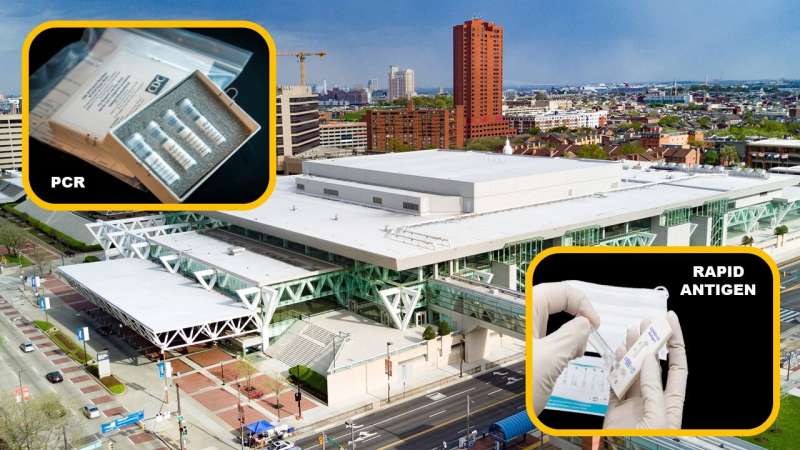
In what is believed to be the largest prospective study of its kind to date—involving some 6,000 patients seen at the Baltimore Convention Center Field Hospital (BCCFH) during a 10-day period around the beginning of 2021—researchers at Johns Hopkins Medicine, the University of Maryland Medical Center, the University of Maryland School of Medicine and four other collaborators report that a rapid antigen detection test for SARS-CoV-2, the virus that causes COVID-19, proved more effective than expected when compared with virus detection rates using the established standard test, the polymerase chain reaction (PCR) assay.
The study was first posted online Dec. 1, 2021, in the American Society for Microbiology journal Microbiology Spectrum.
“We found that virus was accurately detected by the rapid antigen test in 87% of patients with COVID-19 symptoms and in 71% of those who were asymptomatic—rates that surprised us because they were so high,” says study lead author Zishan Siddiqui, M.D., assistant professor of medicine at the Johns Hopkins University School of Medicine. “This is a significant finding because the rapid test offers a number of advantages over the PCR test, including time savings, both in sampling and processing; cost savings; and most importantly, ease of distribution and application—basically anywhere—which can help overcome COVID testing disparities in medically underserved communities.”
The first step for both the PCR and rapid antigen tests is obtaining a sample from a patient, either a nasal swab or a bit of saliva. The difference lies in how the sample is processed and analyzed. A PCR test takes a tiny bit of SARS-CoV-2 genetic material from a sample and reproduces it thousands of times so it can be more easily detected. A rapid antigen test uses laboratory-produced antibodies to seek out and latch onto proteins on the surface of SARS-CoV-2 particles in the sample.
The PCR test requires a skilled laboratory technician, special equipment and up to an hour or more to process. Additionally, testing on a massive scale can only be conducted at a large, centralized testing facility, such as a hospital laboratory.
On the other hand, rapid antigen testing uses a premade kit with a reagent that contains antibodies specific for SARS-CoV-2. The test can be conducted by anyone after brief training, can be administered anywhere and provides results in approximately 15 minutes.
The question that the new study hoped to answer was which test could be most broadly, most quickly and most effectively applied to a large community such as Baltimore.
To do this, the researchers administered both the rapid antigen and PCR detection methods to just over 6,000 people who came to the Baltimore field hospital for COVID testing between Dec. 23, 2020, and Jan. 11, 2021. Participants were screened for possible exposure to the coronavirus and COVID-19 symptoms. Staff members performing the tests were trained exactly the same and monitored during test administration to ensure quality control and reliable results.
“What we determined was that while the PCR test may be a better test from a clinical perspective—as it’s basically 100% accurate at detecting SARS-CoV-2—the rapid antigen test appears to be better from a public health standpoint because of its ease of use, and the fact that it proved to have sufficient accuracy, specificity and reliability for detecting the coronavirus in a high-volume setting,” says study senior author James Ficke, M.D., professor of orthopedic surgery at the Johns Hopkins University School of Medicine and co-director of the BCCFH for 16 months. “The field hospital was the perfect place to determine this because we could see how well both tests worked for a large number of people in a short amount of time.”
Operated since April 2020 as a collaboration between Johns Hopkins Medicine, the University of Maryland Medical System and the Maryland Department of Health, the BCCFH provided COVID-19 testing, monoclonal antibody infusion therapy and vaccinations to Baltimore-area residents, including those in medically underserved communities.
“The ability of the BCCFH to test people who would traditionally have had limited access to such procedures was critical for our study because it also enabled us to see if rapid antigen or PCR testing was the best means of tackling that disparity,” says Ficke. “That’s important, because the more we can get tests out to all members of the community, the stronger our effort to reduce the spread of COVID-19.”
The study findings have been put to good use from the beginning, says Siddiqui.
“The accuracy of the rapid antigen test was mostly unknown when we started the study in December 2020,” says Siddiqui. “We shared our findings with the Maryland Department of Health and in scientific meetings a month later, and before the results of any similar studies were available. I believe this influenced the state’s strategy on how best to use the rapid antigen tests available to them.”
What made this study so valuable, adds Ficke, were the “perfect location and team” conducting it—a field hospital that became one of the largest COVID testing sites in the nation and a solid partnership among Johns Hopkins, the University of Maryland, the state of Maryland and the clinicians from the Greater Baltimore area who served there.
“Our successful program has shown that a health care system can provide an equitable response to COVID-19 because the rapid antigen test makes it possible to test all socioeconomic levels of a large population quickly and repeatedly—and this has become the model that the state of Maryland is actively putting into practice and other organizations are starting to follow,” he says.
Siddiqui, Ficke and their colleagues are comparing rapid antigen and PCR testing in pediatric patients, with data collected on about 1,000 children so far. They hope to publish their findings early in 2022.
Source: Read Full Article
